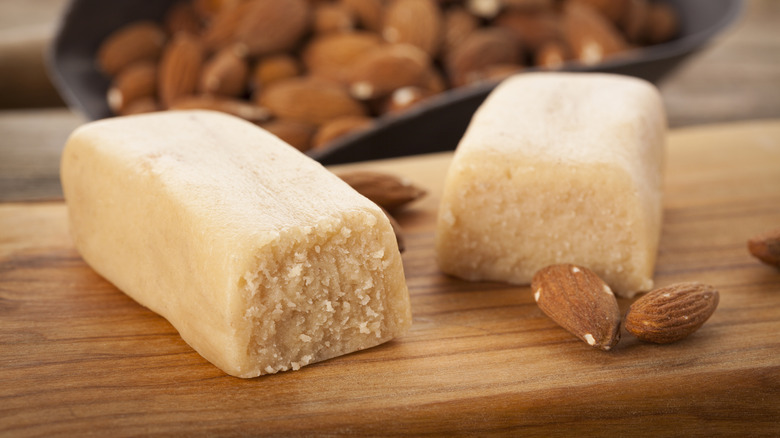What Is Marzipan Made Of?
The sweet, confectionary delight known by the name of marzipan is popular across the globe. Often found sitting behind the window of pastry shops all around the world, the origins of this candy are widely disputed. Many claim that it comes from the charming city of Lübeck, Germany, although it has reportedly been made in the Middle East and Mediterranean regions for centuries, too.
No matter where it came from, this treat is now widely beloved for its sweet, nutty flavor which comes from its simple blend of confectioner's sugar, ground almonds, and egg whites. This gives the treat its signature sweet taste and a smooth, moldable texture (as well as a satisfying grittiness, thanks to those ground-up almonds). Sometimes almond extract is also added to bring extra flavor, as well as gelatin or corn syrup to help the mixture blend and hold its shape more effectively.
While you can buy a log of raw marzipan, this treat is more often enjoyed when it's covered in a colorful shell and made to resemble a variety of things, including realistic fruits, vegetables, plants, and even animals. Because it's so easy to mold, many cultures have different shapes and traditions that relate to marzipan. For example, eating a marzipan pig is considered good luck in Germany, and it's custom to gift one to friends and family around Christmastime.
The many different forms of marzipan
In France, marzipan is sometimes coated in a decadent shell of chocolate. Other countries like Germany use it as a protective layer over fruitcakes to keep them from going stale, so chefs will rarely have to worry about how to revive an old cake. You can even use marzipan as a replacement for fondant to cover pastry, or to form into little carrots to make a perfect carrot cake even better with the perfect decoration. Many people choose to enjoy this treat simply as candy when it is dyed and formed into a cute shape, then sold in little trays like artisan chocolates.
Baking enthusiasts might mistake marzipan for almond paste, but they're actually not the same at all. Although both are made from nearly the same ingredients, almond paste is slightly less sweet and is more commonly used to enhance baking projects, while marzipan is often eaten and enjoyed on its own.
While many love marzipan, others are not big fans of the nutty taste of this treat, so it can be considered a divisive sweet. If you're interested in trying some for yourself, marzipan sweets are commonly found in confectionary stores across Europe and parts of North America. You can also make some yourself at home with sugar, almond flour, and egg whites, as well as any flavorings you wish to add.

